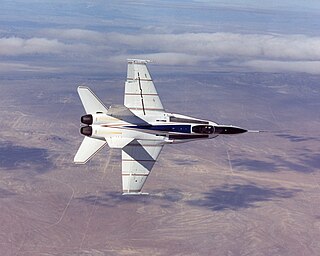
Avionics are the electronic systems used on aircraft, artificial satellites, and spacecraft. Avionic systems include communications, navigation, the display and management of multiple systems, and the hundreds of systems that are fitted to aircraft to perform individual functions. These can be as simple as a searchlight for a police helicopter or as complicated as the tactical system for an airborne early warning platform. The term avionics is a portmanteau of the words aviation and electronics.

The McDonnell Douglas F-15 Eagle is an American twin-engine, all-weather tactical fighter aircraft designed by McDonnell Douglas to gain and maintain air supremacy in all aspects of aerial combat. Following reviews of proposals, the United States Air Force selected McDonnell Douglas's design in 1967 to meet the service's need for a dedicated air-superiority fighter. The Eagle first flew in July 1972, and entered service in 1976. It is among the most successful modern fighters, with over 100 victories and no losses in aerial combat, with the majority of the kills by the Israeli Air Force.

The Lockheed Martin F-22 Raptor is a fifth-generation, single-seat, twin-engine, all-weather stealth tactical fighter aircraft developed for the United States Air Force (USAF). The result of the USAF's Advanced Tactical Fighter (ATF) program, the aircraft was designed primarily as an air superiority fighter, but also has ground attack, electronic warfare, and signal intelligence capabilities. The prime contractor, Lockheed Martin, built most of the F-22's airframe and weapons systems and conducted final assembly, while Boeing provided the wings, aft fuselage, avionics integration, and training systems.

The McDonnell F-101 Voodoo was a supersonic jet fighter which served the United States Air Force (USAF) and the Royal Canadian Air Force (RCAF).

Fourth-generation jet fighter is a general classification of jet fighters in service from approximately 1980 to the present and represent design concepts of the 1970s. Fourth-generation designs are heavily influenced by lessons learned from the previous generation of combat aircraft. Long-range air-to-air missiles, originally thought to make dogfighting obsolete, proved less influential than expected, precipitating a renewed emphasis on maneuverability. Meanwhile, the growing costs of military aircraft in general and the demonstrated success of aircraft such as the F-4 Phantom II gave rise to the popularity of multirole combat aircraft in parallel with the advances marking the so-called fourth generation.

An autopilot is a system used to control the trajectory of an aircraft without constant 'hands-on' control by a human operator being required. Autopilots do not replace human operators, but instead they assist them in controlling the aircraft. This allows them to focus on broader aspects of operations such as monitoring the trajectory, weather and systems.

The McDonnell DouglasX-36Tailless Fighter Agility Research Aircraft was an American stealthy subscale prototype jet designed to fly without the traditional tail assembly found on most aircraft. This configuration was designed to reduce weight, drag and radar cross section, but increase range, maneuverability and survivability.

Thrust vectoring, also thrust vector control or TVC, is the ability of an aircraft, rocket, or other vehicle to manipulate the direction of the thrust from its engine(s) or motor(s) in order to control the attitude or angular velocity of the vehicle.

A conventional fixed-wing aircraft flight control system consists of flight control surfaces, the respective cockpit controls, connecting linkages, and the necessary operating mechanisms to control an aircraft's direction in flight. Aircraft engine controls are also considered as flight controls as they change speed.

Low Altitude Navigation and Targeting Infrared for Night, or LANTIRN, is a combined navigation and targeting pod system for use on the USAF's premier fighter aircraft — the F-15E Strike Eagle and F-16 Fighting Falcon. LANTIRN significantly increases the combat effectiveness of these aircraft, allowing them to fly at low altitudes, at night and under-the-weather to attack ground targets with a variety of precision-guided weapons.
Energy–maneuverability theory is a model of aircraft performance. It was developed by Col. John Boyd, a fighter pilot, and Thomas P. Christie a mathematician with the Air Force, and is useful in describing an aircraft's performance as the total of kinetic and potential energies or aircraft specific energy. It relates the thrust, weight, aerodynamic drag, wing area, and other flight characteristics of an aircraft into a quantitative model. This allows combat capabilities of various aircraft or prospective design trade-offs to be predicted and compared.

The X-53 Active Aeroelastic Wing (AAW) development program is a completed American research project that was undertaken jointly by the Air Force Research Laboratory (AFRL), Boeing Phantom Works and NASA's Dryden Flight Research Center, where the technology was flight tested on a modified McDonnell Douglas F/A-18 Hornet. Active Aeroelastic Wing Technology is a technology that integrates wing aerodynamics, controls, and structure to harness and control wing aeroelastic twist at high speeds and dynamic pressures. By using multiple leading and trailing edge controls like "aerodynamic tabs", subtle amounts of aeroelastic twist can be controlled to provide large amounts of wing control power, while minimizing maneuver air loads at high wing strain conditions or aerodynamic drag at low wing strain conditions. The flight program which first proved the use of AAW technology in full scale was the X-53 Active Aeroelastic Wing program.

The Vought XF8U-3 Crusader III was an aircraft developed by Chance Vought as a successor to the successful Vought F-8 Crusader program and as a competitor to the McDonnell Douglas F-4 Phantom II. Though based in spirit on the F8U-1 and F8U-2, and sharing the older aircraft's designation in the old Navy system, the two aircraft shared few parts.

The Wright Brothers Medal was conceived of in 1924 by the Dayton Section of the Society of Automotive Engineers, and the SAE established it in 1927 to recognize individuals who have made notable contributions in the engineering, design, development, or operation of air and space vehicles. The award is based on contributed research papers.
Gordon G. Grose was an engineer at the McDonnell-Douglas Corporation. He won the Wright Brothers Medal in 1974 with Michael J. Wendl, J. L. Porter, and Ralph Pruitt for a paper discussing future aircraft designs that integrate fly-by-wire controls with engine inlets/nozzles and advanced pilot displays.
V. Ralph Pruitt was an engineer at McDonnell Douglas who won the Wright Brothers Medal in 1974 with Michael J. Wendl, Gordon G. Grose, and J. L. Porter for a paper discussing future aircraft designs that integrate fly-by-wire controls with engine inlets/nozzles and advanced pilot displays.
The Westinghouse Aviation Gas Turbine Division (AGT) was established by Westinghouse Electric Corporation in 1945 to continue the development and production of its turbo-jet gas turbine engines for aircraft propulsion under contract to the US Navy Bureau of Aeronautics. The AGT Division was headquartered in Kansas City, Missouri, where it remained in operation until 1960 when Westinghouse decided to focus on industrial and electric utility gas turbines.
Jet fighters generations are categories created to separate major technology leaps in the historical development of jet fighters. The term generation first appeared in the 1990s, according to the Royal Australian Air Force's Air Power Development Centre Bulletin: "to make sense of the leap-frogging improvements in performance to jet fighter aircraft brought about through major advances in aircraft design, avionics, and weapon systems". and proposes that a "generational shift in jet fighter aircraft occurs when a technological innovation cannot be incorporated into an existing aircraft through upgrades" and retrofits.
Most of the terms listed in Wikipedia glossaries are already defined and explained within Wikipedia itself. However, glossaries like this one are useful for looking up, comparing and reviewing large numbers of terms together. You can help enhance this page by adding new terms or writing definitions for existing ones.


















